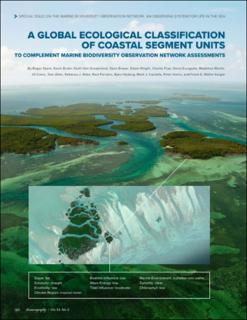A global ecological classification of coastal segment units : To complement marine biodiversity observation network assessments
Sayre, Roger; Butler, Kevin; Van Graafeiland, Keith; Breyer, Sean; Wright, Dawn; Frye, Charlie; Karagulle, Deniz; Martin, Madeline; Cress, Jill; Allen, Tom; Allee, Rebecca J.; Parsons, Rost; Nyberg, Björn Johan Emil Burr; Costello, Mark John; Harris, Peter; Muller-Karger, Frank E.
Peer reviewed, Journal article
Published version

View/
Date
2021Metadata
Show full item recordCollections
Original version
Sayre, R., Butler, K., Van Graafeiland, K., Breyer, S., Wright, D., Frye, C., Karagulle, D., Martin, M., Cress, J., Allen, T., Allee, R. J., Parsons, R., Nyberg, B., Costello, M. J., Harris, P. & Muller-Karger, F. E. (2021). A global ecological classification of coastal segment units: To complement marine biodiversity observation network assessments. Oceanography, 34(2), 120-129. doi: 10.5670/oceanog.2021.219Abstract
A new data layer provides Coastal and Marine Ecological Classification Standard (CMECS) labels for global coastal segments at 1 km or shorter resolution. These characteristics are summarized for six US Marine Biodiversity Observation Network (MBON) sites and one MBON Pole to Pole of the Americas site in Argentina. The global coastlines CMECS classifications were produced from a partitioning of a 30 m Landsat-derived shoreline vector that was segmented into 4 million 1 km or shorter segments. Each segment was attributed with values from 10 variables that represent the ecological settings in which the coastline occurs, including properties of the adjacent water, adjacent land, and coastline itself. The 4 million segments were classified into 81,000 coastal segment units (CSUs) as unique combinations of variable classes. We summarize the process to develop the CSUs and derive summary descriptions for the seven MBON case study sites. We discuss the intended application of the new CSU data for research and management in coastal areas.
